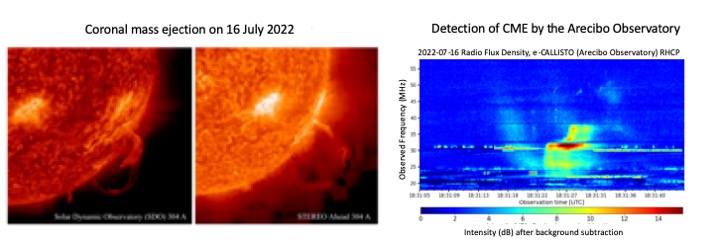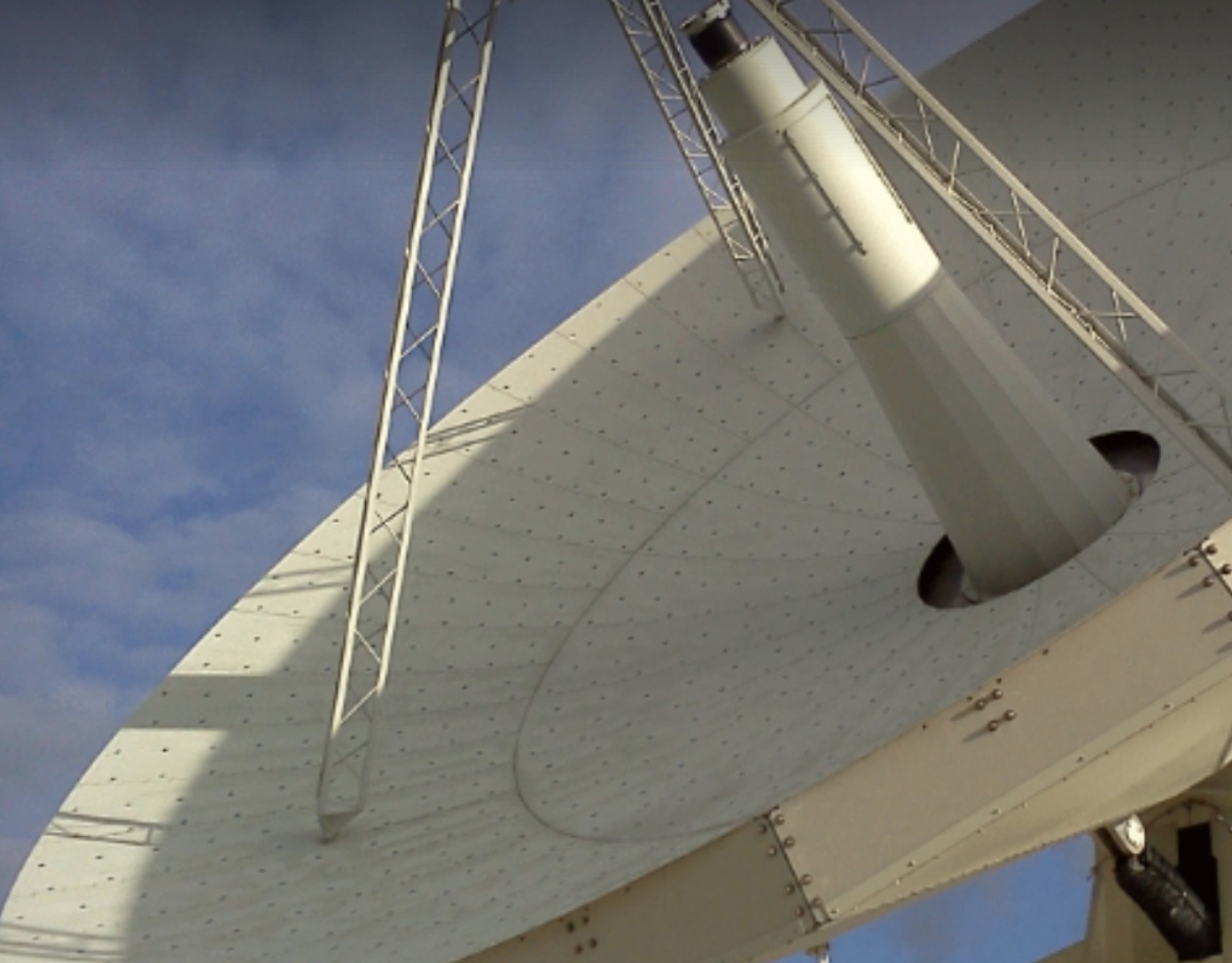
An illustration of the Sun interacting with Earth’s magnetosphere. Credit: NASA's Goddard Space Flight Center/Mary Pat Hrybyk-Keith
At the Arecibo Observatory (AO), the upgraded 12-meter telescope and the newly-installed Callisto solar radio spectrometer are actively observing the Sun and regularly detecting space weather events. These radio-band observations are contributing unique pieces to the many outstanding puzzles about the Sun’s activity and its effect on Earth.
AO Callisto
 File link: .png
File link: .png
CALLISTO Radio Spectrometer Plot - Frequency (MHz) vs Observation Time (UTC)

This website is currently under construction. Soon we will be presenting the most recent data plots in this section. .
Large Coronal Mass Ejection Detection with AO Callisto: On July 16th, 2022, the Callisto spectrometer recorded reverve bursts associated with a large Coronal Mass Ejection. The bursts are signatures of electron beams traveling along closed magnetic loops and are likely the first detections of such bursts using the AO spectrometer. NASA’s Solar Dynamic Observatory (SDO) and STEREO missions, which are space-based telescopes, captured images of the CME at the near-Sun region, as can be seen in the images in Figure 2.

Figure 2: (Right) The Arecibo Observatory captured an intense radio burst on the 16th of July using the CALLISTO radio spectrometer. (Left) Two space-based NASA telescopes simultaneously imaged a large Coronal Mass Ejection from the Sun.
Independence Day Solar Flare: While the U.S. celebrated their Independence Day, the Sun was setting off some fireworks of its own. An X-ray flare from the Sun was detected by the AO Callisto spectrometer. Follow-up observations using the 12-meter telescope show the region of the Sun where the flare originated from. Although this flare was a moderate event, it was well-recorded by both the Callisto spectrometer and the 12-m telescope, showing how sensitive both instruments are for detecting and developing accurate forecasting of space weather events.

Figure 3: The Arecibo Observatory captured a solar flare event on the 4th of July 2022. The image on the left shows the signal collected from the Sun by the 12-m radio telescope at 8647 MHz. The bright spot seen in the radio image from the 12-m telescope (the green arrow) corresponds with where an X-ray flare had been detected by other telescopes. In the center, there is an image collected by the NASA Solar Dynamics Observatory (SDO). It similarly shows activity in the same region detected by the 12-m telescope. On the right, the spectrum shows high intensity signal that was captured by the CALLISTO radio spectrometer at Arecibo corresponding with the time of the solar flare.

Solar Mapping with the 12-m: Since its upgrade in December of 2021, the 12-meter telescope at AO has been used to create daily maps of the Sun in the frequency range of 8.1 - 9.3 GHz. The regular monitoring of the solar emission observed at 8.6 GHz clearly detects the magnetically active regions on the Sun that are capable of producing space weather events, including intense solar flares and energetic CMEs.

Space Weather Events with the AO Callisto: Since its installation at AO in October of 2021, the AO Callisto solar radio spectrometer has detected numerous space weather events. The AO Callisto is one of the most active e-CALLISTO radio spectrometers that make up an international network of telescopes (see Figure 1). The Callisto instrument operates from 15 - 100 MHz and continually observes the Sun from 6 AM - 6 PM AST, with new data being uploaded to the e-Callisto site every 15 minutes. At these frequencies, the e-Callisto network is measuring radiation caused by electron beams, shocks, possibly trapped electrons, and high-frequency waves in the plasma emitted by the Sun during events.

Figure 1: Plot from the e-CALLISTO solar spectrometer site that shows various locations of the e-Callisto radio spectrometers and the number of solar radio bursts observed in the month of April. The network allows 24 hour monitoring of the Sun. The AO Callisto routinely captures some of the highest number of solar radio bursts events each month.
What is Space Weather and Why Does it Matter?
Dr. P. K. Manahoran of the Arecibo Observatory breaks down the science behind space weather, how it affects us on Earth, and how we are able study and even predict space weather events.
When discussing the weather, most people talk about the clouds, rain, or temperature. Scientists at the Arecibo Observatory, however, have been focused on a different type of weather: Space Weather.
Space weather describes variations in the space environment between the Sun and the Earth, often caused by events or “storms” on the Sun. One type of very energetic solar storm, known as a Coronal Mass Ejection (CME), releases a significant amount of plasma and accompanying magnetic field from the Sun into the solar wind. High-energy particles emitted from the Sun are associated with solar flares and shock waves driven by CMEs. They range in energy from tens of keV to a few Gev are an important contributor to the characterization of the space environment and they pose threat to any spacecraft, astronauts, or even future human bases on the moon.
The arrival of an energetic CME at the near-Earth environment can produce a geomagnetic storm, which can cause anomalies. Fluctuating magnetic fields associated with these storms induce currents in long wires like power lines, potentially leading to wide-spread blackouts in extreme cases. In terms of significant economical impacts of space weather events, the historical solar observations over two centuries clearly point to “greatest storms” caused by ultra intense flares and their associated coronal mass ejections (CMEs) directed towards the Earth.
The CMEs that arrive at the Earth can lead to plasma injection into the ionosphere, in turn, increasing the electron density and can have a serious impact on technology both on the ground and on spacecraft that orbit the Earth, including GPS and communications satellites. Therefore, there is a growing practical need to accurately forecast the potential impact of large space weather events.
Forecasting Space Weather relies on the routine monitoring and understanding of the Sun’s magnetic activities. Scientists are making efforts to spot active regions of the Sun several hours a day before they erupt, providing some time to prepare for the enhanced space weather, if needed.
Why is studying Space Weather important?
During strong solar storms, material from the coronal mass ejections can collide with the Earth's magnetosphere. The disturbance can trigger a series of events that sends a burst of particle radiation into Earth's upper atmosphere.
During an intense magnetic storm, the upper atmosphere is heated and expands upwards. This heating of the upper atmosphere results in increased drag forces on the satellites that orbit the Earth, including GPS and communication satellites. Enhanced drag directly impacts the operations of spacecraft, for instance, orbital tracking and predictions, maneuvers, and lifetime maintenance. Additionally the Sun’s energetic particles can cause direct radiation damage to spacecraft components such as large solar cell arrays. This can reduce the efficiency of the solar cells and shorten the lifetime of the spacecraft by several years, or potentially destroy the spacecraft entirely.
The most famous technological disruption to Earth that has been attributed to a series of Coronal Mass Ejections is known as the Carrington Event. It occurred in 1859 and caused global telegraph lines to spark and even catch fire. A similar event could be catastrophic to the far-more sensitive technologies we depend on day-to-day, highlighting the importance of studying Space Weather. The severity of geomagnetic storms (Dst index) depends on the impacting magnetic field orientation and the strength of the shock ahead of the CME. At present, predicting the orientation of the magnetic field within a CME is a real challenging problem and a number of numerical modeling and theoretical simulation efforts are being made on this topic.
What do we use to study Space Weather?
At the National Oceanic and Atmospheric Administration (NOAA)’s Space Weather Prediction Center, a large team of scientists work to provide daily briefs on space weather forecasts. A growing number of telescopes that operate over a range of different wavelengths between the X-ray and the radio continually monitor the Sun for solar activities that can create large space weather events. Space-based missions by NASA, NOAA, and ESA provide solar and solar wind data at an unprecedented temporal/spatial resolution. Some of these missions, located at the first Lagrangian point (L1), offer an uninterrupted view of the Sun and interplanetary space.
On Earth, there are a number of solar observations, including the largest ground-based solar telescope, DKIST. Arrays such as the e-CALLISTO, support those efforts. With all of these facilities, we can observe the activity at the Sun, while spacecraft orbiting the Earth can detect space weathering near the planet. However, there are a lack of observations in the regions of space between the Sun and the Earth.
What creates Space Weather events?
Active regions on the Sun typically form as a result of the emergence of toroidal magnetic flux from the deeper convection zone of the Sun. That emerging flux can get amplified by turbulence and shear in the thin shear layer at the vase of the Sun’s convection zone, called the tachocline. Solar flares and coronal mass ejections from these regions depend on its magnetic morphology (e.g., complexity). Their strength is not only defined by the outburst of electromagnetic radiation over a large range of wavelengths, but also includes the entire process in which the magnetic energy is released through magnetic reconnection and plasma instability, emanating from the active region in which high magnetic non-potentiality plays a role in a wide variety of forms. The coronal mass ejections are observed as an expulsion of a large cloud of plasma. The plasma consists of protons, electrons, alpha particles, and some heavier ions. Most of the fast CMEs include the acceleration of solar energetic particles by CME-driven shocks.
The propagation of a CME and its associated shock along the “Sun-Earth” line or elsewhere depends on the internal magnetic energy carried by the CME itself, as well as the ambient solar wind along its path. A CME launched into the solar wind can go through a large expansion and interaction with large-scale solar wind structures and other CMEs on the way from the Sun to Earth. In the near-Sun region, the size of the CME is of the order of the size of the entire Sun, and at the orbit of the Earth, it can extend the entire distance between the Sun and the Earth (1 AU). The drag experienced by the CME largely determines the CME’s speed and density profiles between Sun and 1-AU and beyond. Eventually the transfer of energy from CME to the solar wind or vice versa decides the acceleration and/or deceleration of the CME propagation. This knowledge is essential for accurately forecasting the arrival of the CME at the Earth’s magnetosphere.
The Arecibo Observatory is well-primed to perform observations of the Sun, contributing to our better understanding and forecasting of Space Weather. The team of scientists and engineers involved in these projects include: P K Manoharan, Christiano Brum, Phil Perillat, Alfredo Santoni, and Felix Fernandez.
Text written by Dr. P.K. Manoharan - Senior Observatory Scientist (mano@naic.edu) & Dr. Tracy Becker - AO Collaborator / SwRI Research Scientist
(tbecker@swri.edu)


